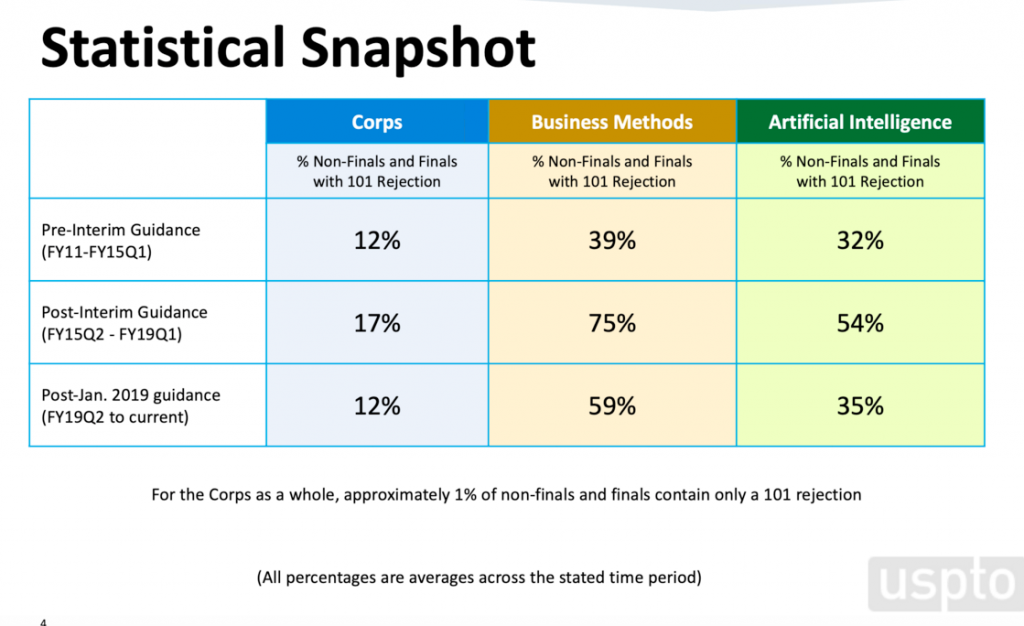“The market is telling us maybe it’s not quite as bad as we think—maybe we’ve found a way forward.” – Kent Richardson

Drew Hirshfeld
Panelists in this past Thursday’s IPWatchdog webinar, “Dissecting Alice,” gave credit to the U.S. Patent and Trademark Office (USPTO) for the steps it has taken to minimize the damage caused by the courts’ lack of action on patent eligibility, but expressed concern that it simply isn’t enough.
USPTO Commissioner for Patents Drew Hirshfeld joined the webinar to report on the progress made since the decision came out and said that, while Alice undoubtedly caused some confusion and disarray for practitioners, “we’re in a better place today than we were two or five years ago.” Hirshfeld explained that the Office’s initial approach to providing guidance for examiners on Alice was to use a “case law matching process,” which eventually became untenable after years of case law had built up. He said that the January 2019 Guidance—which Hirshfeld noted is also binding on the Patent Trial and Appeal Board—was developed over an intensive eight-month period by a small team of people that included Director Andrei Iancu himself and involved at least one full Sunday. He added that the examiner training effort for the 101 Guidance has also been more thorough than any he’s seen in his 25 years at the USPTO. The Office is currently in the process of developing additional concrete case examples for examiners and practitioners to work with in order to further enhance the guidance.
Despite the Office’s efforts, Iancu himself notably commented on June 19 that Congress is going to have to fix the problem.
Never Feel Comfortable

Russell Slifer
Russell Slifer, Principal at Schwegman Lundberg & Woessner and former USPTO Deputy Under Secretary of Commerce for Intellectual Property and Deputy Director, commended Hirshfeld and the Office for the thoughtful and open process and for taking the lead on something Slifer said the courts should have. However, Slifer expressed concern that USPTO guidance for examiners is supposed to represent settled law, which he said Alice is clearly not. Pointing to the recent Cleveland Clinic and Chargepoint cases, Slifer said the Federal Circuit has clearly shown that it has no intention of using the approach outlined in the guidance, which means that patent owners should never feel comfortable that their granted patents are going to survive. Hirshfeld later took issue with this analysis. “I’m somewhat concerned when we say a single case overrides our guidance,” he said, adding that the Federal Circuit often disagrees with the Office on the proper application of the laws when assessing patents, but that does not usually change their practice.
Silver Linings

Kent Richardson
Meredith Addy of AddyHart P.C. and Kent Richardson of Richardson Oliver Law Group were also disturbed by the state of the law since Alice but found some hope.
Richardson said that the market is very adaptive and, despite the impact of Alice on software, “software patents still sell at the highest price. The market is telling us maybe it’s not quite as bad as we think—maybe we’ve found a way forward.”

Meredith Addy
Despite her deep distress over the Federal Circuit’s recent trend of issuing Rule 36 decisions on 101 cases—many of which she said involve good patents—and failing to provide clarity, Addy said that one positive result is that not as many patents include overly broad claims today, since applicants want a “more fleshed out patent.” “That’s a positive,” she said.
Looking at the Numbers
Hirshfeld provided the stats below to show that 101 rejections have come down significantly across all areas since the January guidance, which the panelists were not surprised by, as all agreed the guidance is clear and provides consistency. The question seems to be whether those numbers matter.
“Great progress has been made [since Alice] in understanding and adapting, but without legislative intervention, we have another five years of uncertainty in front of us,” Slifer said.
Listen to the full webinar here.


![[IPWatchdog Logo]](https://ipwatchdog.com/wp-content/themes/IPWatchdog%20-%202023/assets/images/temp/logo-small@2x.png)

![[Advertisement]](https://ipwatchdog.com/wp-content/uploads/2024/04/Artificial-Intelligence-2024-REPLAY-sidebar-700x500-corrected.jpg)
![[Advertisement]](https://ipwatchdog.com/wp-content/uploads/2024/04/UnitedLex-May-2-2024-sidebar-700x500-1.jpg)
![[Advertisement]](https://ipwatchdog.com/wp-content/uploads/2024/04/Patent-Litigation-Masters-2024-sidebar-700x500-1.jpg)

![[Advertisement]](https://ipwatchdog.com/wp-content/uploads/2021/12/WEBINAR-336-x-280-px.png)
![[Advertisement]](https://ipwatchdog.com/wp-content/uploads/2021/12/2021-Patent-Practice-on-Demand-recorded-Feb-2021-336-x-280.jpg)
![[Advertisement]](https://ipwatchdog.com/wp-content/uploads/2021/12/Ad-4-The-Invent-Patent-System™.png)






Join the Discussion
One comment so far.
American Cowboy
June 25, 2019 09:36 amEileen and Gene, I must have let a bad word slip into a comment last week, and now I am barred from your esteemed blog — not even allowed to read it!
Can I get released, please?